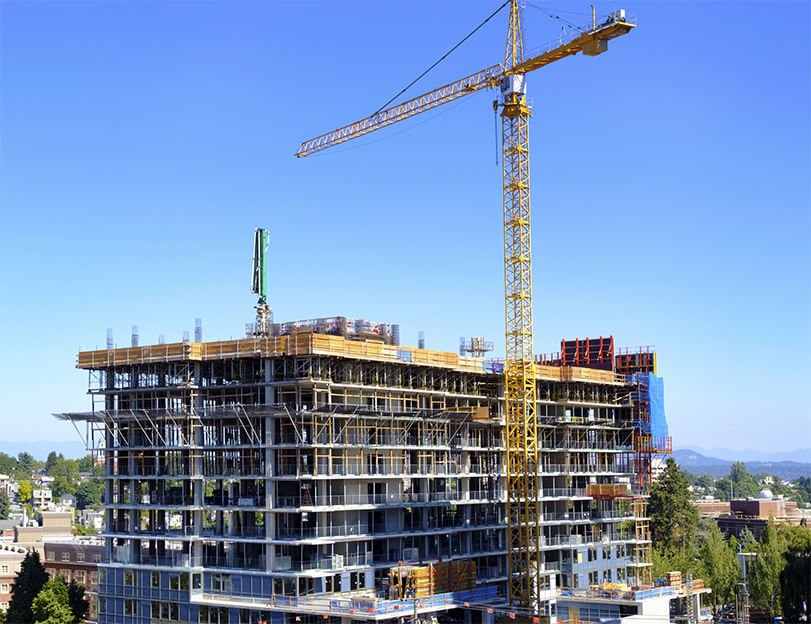3. Choose the right material
The cement number is generally not less than 425#; the fine aggregate requires the selection of river sand with uniform particles, smooth and hard texture, and should be medium sand with an average particle size of about 0.4mm, with a mud content of less than 3%, and an appropriate amount of silt sand. Choose the maximum particle size of coarse aggregate reasonably. Generally, except for large volumes, 5-30mm is reasonable, the maximum particle size does not exceed 40mm, and the mud content does not exceed 1% with fine structure, neat particles, and hard texture.
4. Prevent cracks
 Common cracks in concrete buildings include shrinkage cracks, settlement cracks, temperature cracks, etc. Prevent shrinkage cracks and settlement cracks. In addition to the 4 items mentioned above, it is also necessary to pay attention to the concrete’s proper mixing time, do not cut the material too fast when pouring, prevent accumulation, vibrate compactly, and avoid excessive vibration. Generally, the vibrating time is 10-15s/time. Before the initial setting of the concrete, it should be smoothed and calendered. After calendering, it should be cured with a wet grass curtain or sprayed with a curing agent. In summer, the temperature is high, the wind speed is high, and the environment is dry.
Common cracks in concrete buildings include shrinkage cracks, settlement cracks, temperature cracks, etc. Prevent shrinkage cracks and settlement cracks. In addition to the 4 items mentioned above, it is also necessary to pay attention to the concrete’s proper mixing time, do not cut the material too fast when pouring, prevent accumulation, vibrate compactly, and avoid excessive vibration. Generally, the vibrating time is 10-15s/time. Before the initial setting of the concrete, it should be smoothed and calendered. After calendering, it should be cured with a wet grass curtain or sprayed with a curing agent. In summer, the temperature is high, the wind speed is high, and the environment is dry.
Measures to prevent temperature cracks: First, slag cement and fly ash cement should be considered during construction; For mass concrete, use medium heat or low heat cement; At the same time, a certain amount of active admixtures, such as fly ash, slag powder, etc., are added under the condition of ensuring the strength index. Within a specific range, the greater the number of active admixtures used to replace cement, the better the effect of reducing concrete temperature. Besides, it can make full use of the later strength of concrete, reduce cement consumption, and reduce temperature stress. Then add retarding superplasticizer and air-entraining superplasticizer to large volume concrete to improve its workability, fluidity, cohesion, and water retention. Through water reduction, retardation and dispersion, water consumption can be reduced, the density and strength of concrete and hydration heat can be improved. The time of temperature peaks can be delayed.
5. Strengthen maintenance
With improper early maintenance, the cement cannot be hydrated naturally. It will reduce the concrete’s compactness and then affect the impermeability. Therefore, the early wetting and maintenance of concrete must be strengthened and shall not be less than 14 days.

 The causes of concrete damage and destruction include external environmental conditions, internal defects of concrete, and concrete constituent materials. The external environment exists objectively and can hardly be changed. Therefore, improving the durability of concrete must reduce the concrete’s internal defects to enhance the performance and quality of the concrete, reduce the internal defects of the concrete, and extend the service life of the concrete building.
The causes of concrete damage and destruction include external environmental conditions, internal defects of concrete, and concrete constituent materials. The external environment exists objectively and can hardly be changed. Therefore, improving the durability of concrete must reduce the concrete’s internal defects to enhance the performance and quality of the concrete, reduce the internal defects of the concrete, and extend the service life of the concrete building.
 Common cracks in concrete buildings include shrinkage cracks, settlement cracks, temperature cracks, etc. Prevent shrinkage cracks and settlement cracks. In addition to the 4 items mentioned above, it is also necessary to pay attention to the concrete’s proper mixing time, do not cut the material too fast when pouring, prevent accumulation, vibrate compactly, and avoid excessive vibration. Generally, the vibrating time is 10-15s/time. Before the initial setting of the concrete, it should be smoothed and calendered. After calendering, it should be cured with a wet grass curtain or sprayed with a curing agent. In summer, the temperature is high, the wind speed is high, and the environment is dry.
Common cracks in concrete buildings include shrinkage cracks, settlement cracks, temperature cracks, etc. Prevent shrinkage cracks and settlement cracks. In addition to the 4 items mentioned above, it is also necessary to pay attention to the concrete’s proper mixing time, do not cut the material too fast when pouring, prevent accumulation, vibrate compactly, and avoid excessive vibration. Generally, the vibrating time is 10-15s/time. Before the initial setting of the concrete, it should be smoothed and calendered. After calendering, it should be cured with a wet grass curtain or sprayed with a curing agent. In summer, the temperature is high, the wind speed is high, and the environment is dry.




